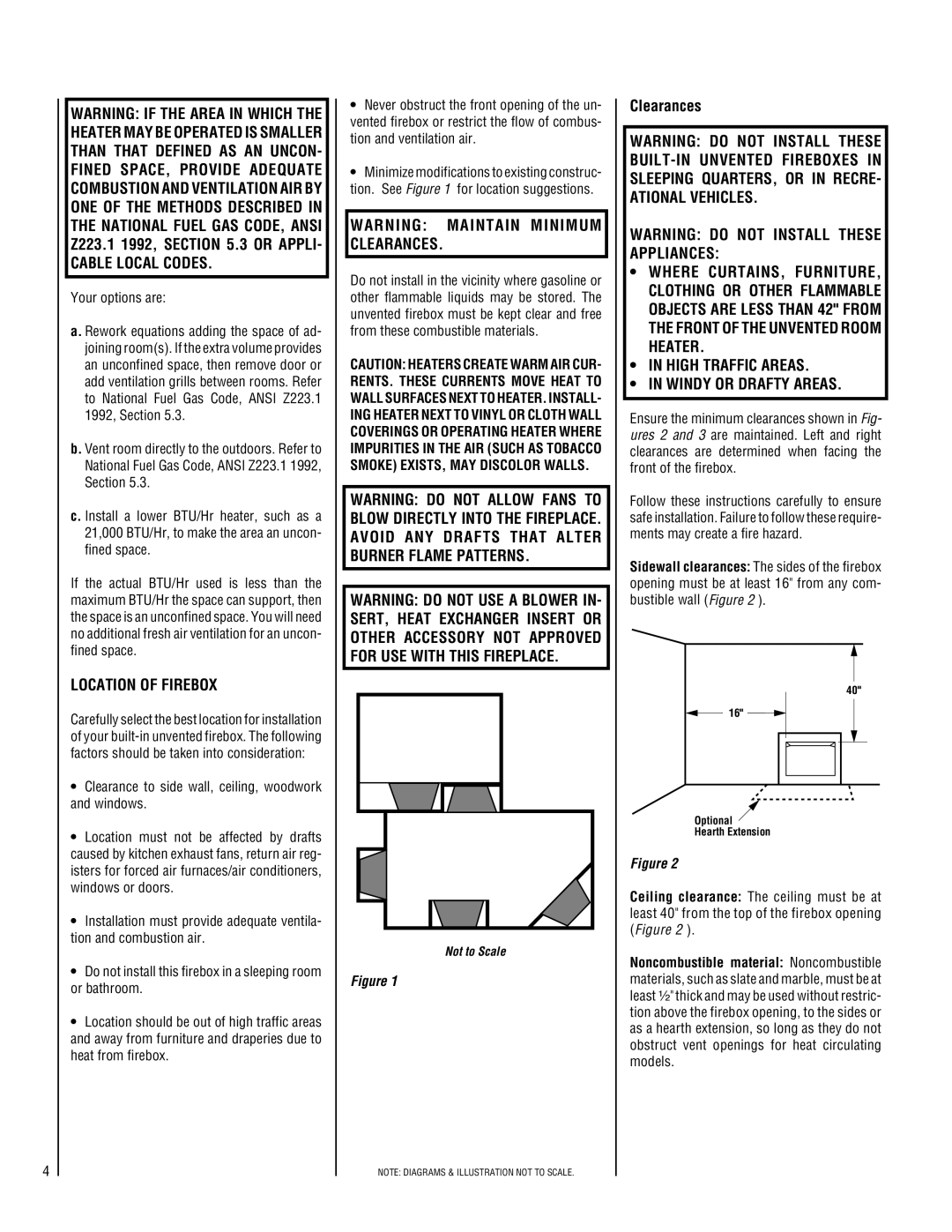
4
WARNING: IF THE AREA IN WHICH THE HEATER MAY BE OPERATED IS SMALLER THAN THAT DEFINED AS AN UNCON- FINED SPACE, PROVIDE ADEQUATE COMBUSTION AND VENTILATION AIR BY ONE OF THE METHODS DESCRIBED IN THE NATIONAL FUEL GAS CODE, ANSI Z223.1 1992, SECTION 5.3 OR APPLI-
CABLE LOCAL CODES.
Your options are:
a. Rework equations adding the space of ad- joining room(s). If the extra volume provides an unconfined space, then remove door or add ventilation grills between rooms. Refer to National Fuel Gas Code, ANSI Z223.1 1992, Section 5.3.
b. Vent room directly to the outdoors. Refer to National Fuel Gas Code, ANSI Z223.1 1992, Section 5.3.
c. Install a lower BTU/Hr heater, such as a 21,000 BTU/Hr, to make the area an uncon- fined space.
If the actual BTU/Hr used is less than the maximum BTU/Hr the space can support, then the space is an unconfined space. You will need no additional fresh air ventilation for an uncon- fined space.
LOCATION OF FIREBOX
Carefully select the best location for installation of your
•Clearance to side wall, ceiling, woodwork and windows.
•Location must not be affected by drafts caused by kitchen exhaust fans, return air reg- isters for forced air furnaces/air conditioners, windows or doors.
•Installation must provide adequate ventila- tion and combustion air.
•Do not install this firebox in a sleeping room or bathroom.
•Location should be out of high traffic areas and away from furniture and draperies due to heat from firebox.
•Never obstruct the front opening of the un- vented firebox or restrict the flow of combus- tion and ventilation air.
•Minimize modifications to existing construc- tion. See Figure 1 for location suggestions.
WARNING: MAINTAIN MINIMUM CLEARANCES.
Do not install in the vicinity where gasoline or other flammable liquids may be stored. The unvented firebox must be kept clear and free from these combustible materials.
CAUTION: HEATERS CREATE WARM AIR CUR- RENTS. THESE CURRENTS MOVE HEAT TO WALL SURFACES NEXT TO HEATER. INSTALL- ING HEATER NEXT TO VINYL OR CLOTH WALL COVERINGS OR OPERATING HEATER WHERE IMPURITIES IN THE AIR (SUCH AS TOBACCO SMOKE) EXISTS, MAY DISCOLOR WALLS.
WARNING: DO NOT ALLOW FANS TO BLOW DIRECTLY INTO THE FIREPLACE. AVOID ANY DRAFTS THAT ALTER BURNER FLAME PATTERNS.
WARNING: DO NOT USE A BLOWER IN- SERT, HEAT EXCHANGER INSERT OR OTHER ACCESSORY NOT APPROVED FOR USE WITH THIS FIREPLACE.
Not to Scale
Figure 1
NOTE: DIAGRAMS & ILLUSTRATION NOT TO SCALE.
Clearances
WARNING: DO NOT INSTALL THESE
WARNING: DO NOT INSTALL THESE APPLIANCES:
•WHERE CURTAINS, FURNITURE, CLOTHING OR OTHER FLAMMABLE OBJECTS ARE LESS THAN 42" FROM THE FRONT OF THE UNVENTED ROOM HEATER.
•IN HIGH TRAFFIC AREAS.
•IN WINDY OR DRAFTY AREAS.
Ensure the minimum clearances shown in Fig- ures 2 and 3 are maintained. Left and right clearances are determined when facing the front of the firebox.
Follow these instructions carefully to ensure safe installation. Failure to follow these require- ments may create a fire hazard.
Sidewall clearances: The sides of the firebox opening must be at least 16" from any com- bustible wall (Figure 2 ).
40"
16"
Optional
Hearth Extension
Figure 2
Ceiling clearance: The ceiling must be at least 40" from the top of the firebox opening (Figure 2 ).
Noncombustible material: Noncombustible materials, such as slate and marble, must be at least ¹⁄₂" thick and may be used without restric- tion above the firebox opening, to the sides or as a hearth extension, so long as they do not obstruct vent openings for heat circulating models.
